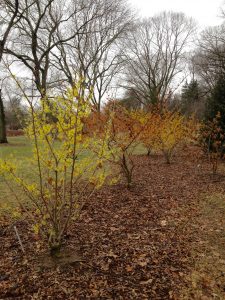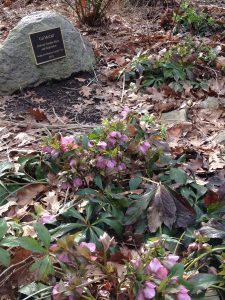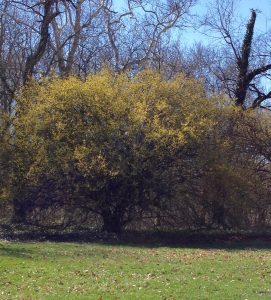Here it is, late February and signs of spring are beginning to be seen in the park. Witch Hazels, Hellebores and the Cornus mas are sure signs that spring is not far away. We hope you visit and enjoy these plants. Too often, they are missed by visitors.
Witch Hazel

The Witch Hazels (Hamamelis) in the park opened the third week in February. These spring blooming Witch Hazels are not the American Witch Hazels, which bloom in the fall. The Park of Roses also has a large native Witch Hazel for which you will have to wait until fall to see blooming!
Our collection of Witch Hazels are Chinese or Japanese in origin and are in shades of yellow and orange delicate flowers. These flowers also have a lovely scent. You will find them on the north side of the park, between the long mall, near the access road. Look closely and you will enjoy this harbinger of spring. If you are interested in having Witch Hazel in your yard, you may want to check this resource for more information.
Helleborus orientalis

Another very early bloomer is the Hellebore, commonly called the Lenten Rose. This is a great plant which produces flowers lasting from March to May. In fact, this picture is was taken March 1, 2017! The Hellebores in the Perennial Garden are in shades of pink and white but a variety of colors, from white, pink, rose, yellow and even black are available. These hardy flowers easily handle snow and cold weather.
Our planting of Hellebores are found in the Perennial Garden in the bed located west of the circle bed. The commemorative rock seen, was installed in 2012 by the Northview Buckeye Garden Club in recognition of Cal McCall for her many years overseeing the Perennial Garden. The Northview Buckeye Garden Club has taken responsibility for the Perennial Garden since 1997. Soon, this year’s volunteers, which include non-garden club members as well, will trim Helebore so that the flowers can take center stage.
Cornus mas

Another plant, soon to bloom will be the Cornus mas or the Cornelian-cherry dogwood. This lovely plant also blooms in March before leaves on trees emerge. In fact, this picture was also taken on March 1, 2017.
The Cornus mas is considered either a small tree or large deciduous shrub, native to Europe and Asia. The two trees in the park will soon be seen in full bloom. Unfortunately, they are too easily missed by many. So, as you walk up the hill to the south end of the shelterhouse, look to your right (south) to see these trees putting on a show with their soft yellow blossoms. It is lovely.
